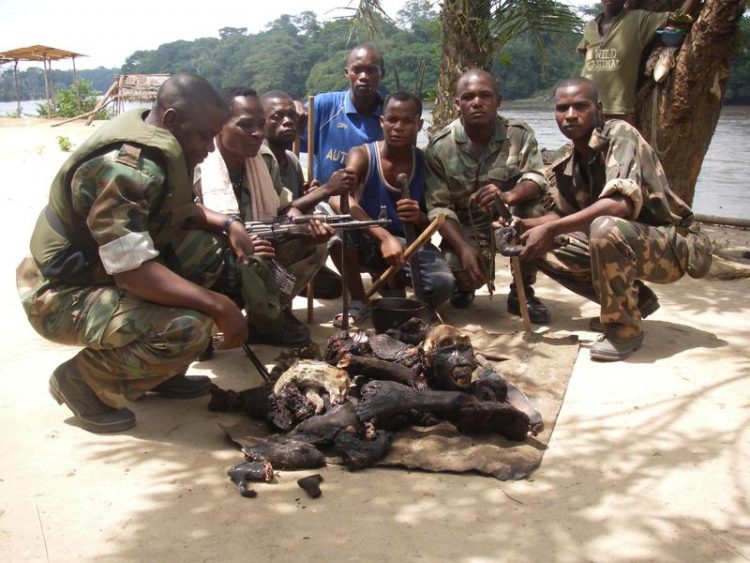Hunting pressure on forest animals in Africa is on the increase

Confiscated bushmeat in Dzanga Sangha WWF
Since about 25 years, animal species in West and Central Africa are no longer being hunted solely for the purpose of local self-sufficiency, but increasingly also for sale in urban areas several hundred kilometres away.
As a consequence, many populations have dramatically decreased or already disappeared altogether. A team of European researchers led by Goethe University Frankfurt has now predicted hunting pressure for the Congo Basin and produced a detailed map, which could help in regional planning.
The hunted species are mostly mammals, but also some reptile and bird species. In many areas, they are the only cheap and easily available source of animal protein for the rural community. However, the commercialization of the bushmeat trade has meanwhile led also to the “Empty Forest Syndrome” in forest ecosystems throughout Africa.
The sale of bushmeat allows the rural community to purchase products or services which go beyond simple self-sufficiency. This has far-reaching ecological consequences, which ultimately also threaten the existence of the rural population. For example, with the disappearance of the herbivorous animals which serve as seed carriers, the forests disappear in the long term too.
The research team led by Bruno Streit analysed reports published between 1990 and 2007 on the bushmeat on sale on markets in the Congo Basin (Cameroon, Central African Republic, Democratic Republic of the Congo, Equatorial Guinea, Gabon and the Republic of the Congo).
On the basis of the number of carcasses openly on sale and the catchment area of the markets, they calculated the annual harvest rates of bushmeat per square kilometre. They then correlated these figures with socio-economic variables, such as population density, the density of the road network and the distance of the markets to the nature reserves. In a further step, they defined different classes of potential hunting pressure.
“For a quarter of the total area, we calculated a level of hunting pressure which was somewhat lower”, explains Professor Bruno Streit of the Institute of Ecology, Evolution and Diversity at Goethe University Frankfurt.
“However, our prediction foresees severe to very severe hunting pressure across 39 percent of the area of the Congo Basin. This is the case above all in areas with a very dense network of traffic routes, often in proximity to nature reserves”, continues Stefan Ziegler of the WWF. Thus the internationally famous Virunga National Park and the Okapi Wildlife Reserve in the east of the Democratic Republic of the Congo also lie in such areas.
The map produced by the researchers could help to support sustainable regional planning by ensuring that – as far as possible – roads do not carve up areas rich in wildlife. The map also identifies neuralgic points where the potential for hunting pressure is particularly high. Anti-poaching measures should concentrate on these zones.
The report stemmed from a joint project between Goethe University Frankfurt, experts in remote sensing at the University of Würzburg, and conservationists from WWF Germany.
Publication: Stefan Ziegler, John E. Fa, Christian Wohlfart, Bruno Streit, Stefanie Jacob and Martin Wegmann: Mapping Bushmeat Hunting Pressure in Central Africa, in: Biotropica, 29 Januar 2016 DOI: 10.1111/btp.12286; http://onlinelibrary.wiley.com/doi/10.1111/btp.12286/abstract
Pictures for dowload: www.uni-frankfurt.de/59967888
Information: Prof. Bruno Streit, Institute for Ecology, Evolution and Diversity, Campus Riedberg, Tel.: (069) 798-42160, -42162, streit@bio.uni-frankfurt.de.
Goethe University is a research-oriented university in the European financial centre Frankfurt founded in 1914 with purely private funds by liberally-oriented Frankfurt citizens. It is dedicated to research and education under the motto “Science for Society” and to this day continues to function as a “citizens’ university”. Many of the early benefactors were Jewish. Over the past 100 years, Goethe University has done pioneering work in the social and sociological sciences, chemistry, quantum physics, brain research and labour law. It gained a unique level of autonomy on 1 January 2008 by returning to its historic roots as a privately funded university. Today, it is among the top ten in external funding and among the top three largest universities in Germany, with three clusters of excellence in medicine, life sciences and the humanities.
Publisher: The President of Goethe University
Editor: Dr. Anne Hardy, Science Communication Officer, Tel: +49(0)69 798-12498, Fax +49(0)69 798-761 12531, sauter@pvw.uni-frankfurt.de
Internet: www.uni-frankfurt.de
Media Contact
All latest news from the category: Ecology, The Environment and Conservation
This complex theme deals primarily with interactions between organisms and the environmental factors that impact them, but to a greater extent between individual inanimate environmental factors.
innovations-report offers informative reports and articles on topics such as climate protection, landscape conservation, ecological systems, wildlife and nature parks and ecosystem efficiency and balance.
Newest articles

Properties of new materials for microchips
… can now be measured well. Reseachers of Delft University of Technology demonstrated measuring performance properties of ultrathin silicon membranes. Making ever smaller and more powerful chips requires new ultrathin…

Floating solar’s potential
… to support sustainable development by addressing climate, water, and energy goals holistically. A new study published this week in Nature Energy raises the potential for floating solar photovoltaics (FPV)…

Skyrmions move at record speeds
… a step towards the computing of the future. An international research team led by scientists from the CNRS1 has discovered that the magnetic nanobubbles2 known as skyrmions can be…





















